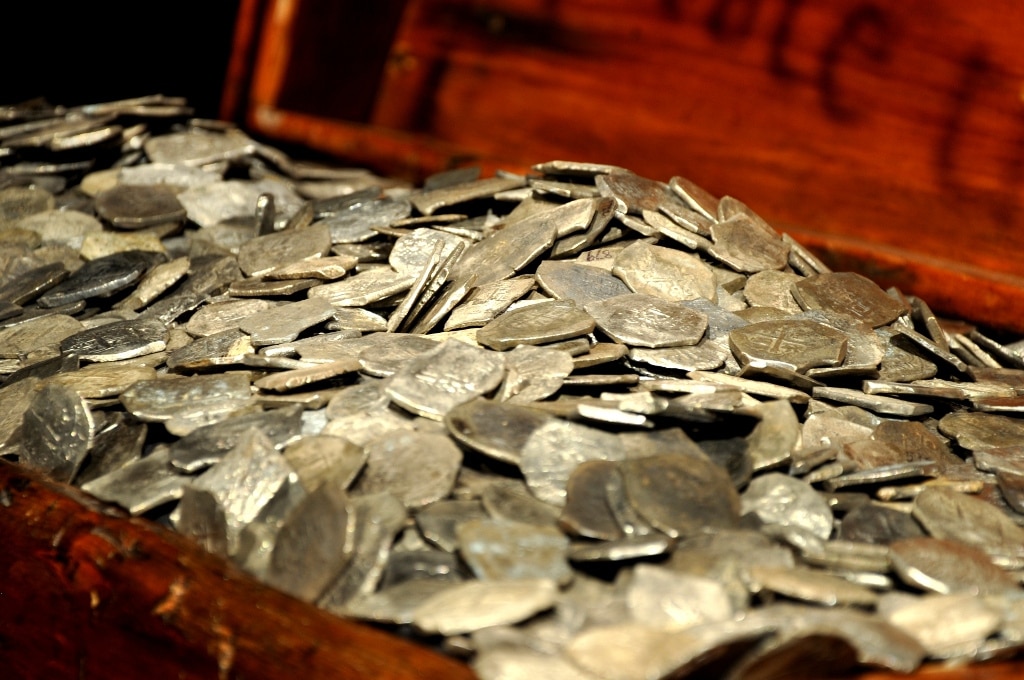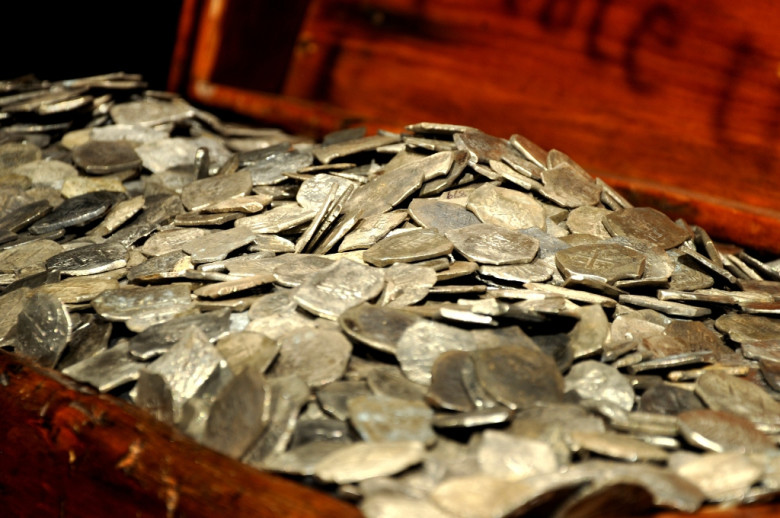The Whydah Gally | Brief History of a Cape Cod Pirate Ship
Discovered off the coast of Wellfleet, MA, the Whydah Gally is the world’s only authenticated pirate ship. Learn more about its fascinating history.

Gold coins recovered from the Whydah Gally by Barry Clifford and his team.
Photo Credit : Wikimedia CommonsNew Englanders love a good mystery — especially as it pertains to the region’s rich maritime history — so it’s no surprise that the sinking of the Whydah Gally has provided generations of curious Yankees with endless legends and lore.
The pirate ship Wydah Gally sank off the coast of Cape Cod on April 26, 1717, prompting sailors and landlubbers alike to ponder the mysteries of its wreck. “Where was the ship’s watery grave?” they wondered, and “How much treasure was actually in its hold?”

Photo Credit : Wikimedia Commons
But these questions would go unanswered for the next 260 years, inspiring stories and hopeful treasure seekers, until underwater explorer Barry Clifford found the ship’s remains in 1984. It was a monumental find, and more than 30 years after its discovery, the Whydah Gally (also known simply as “Whydah“) remains the only fully authenticated and positively identified pirate shipwreck ever recovered.
WHYDAH GALLY | HISTORY OF THE PIRATE SHIP
Built as a slave ship in 1715, the 100-foot, 300-ton Whydah Gally was hijacked during its maiden voyage by the pirate Samuel “Black Sam” Belamy, not long after departing Jamaica. The captain and his crew used the Whydah to pirate other ships before eventually sailing north to the coast of Wellfleet, Massachusetts, where it’s believed that Belamy’s lover, Maria Hallet, was waiting for him.
But the Whydah Gally never reached its destination. As legend has it, the pirate crew was too drunk to finish out the journey and the ship came afoul of a powerful Nor’easter on the night of April 26, 1717. Winds as strong as 70 miles per hour churned the sea, causing swells as high as 30 feet. Although they were within sight of land, the Whydah crew couldn’t navigate the storm and slammed stern-first into a sandbar, breaking apart. Only two of the 146 men on board survived the wreck. It is believed that Bellamy’s ship contained the treasure of 53 other vessels, and as news spread about the Whydah’s lost fortune, people flocked to the beach and waters.
Not long after the ship went down, Colonial Governor Samuel Shute dispatched cartographer Cyprian Southack to recover any lost treasure for the crown. He later reported finding “at least 200 men from several places at 20 miles distance plundering the Pirate Wreck of what came ashore [when] she turned bottom up.”
And just what kind of loot might have been available? According to one of the survivors, the Whydah Gally contained 180 bags of gold and silver the crew had divided equally among themselves.
Over the next two-and-a-half centuries, the mystique surrounding the Whydah continued to mount. Where was the sunken ship? Was there any treasure remaining inside? Would the ship and its loot ever be recovered?

Photo Credit : Wikimedia Commons
The Whydah Gally | Brief History of a Cape Cod Pirate Ship
Enter local underwater explorer Barry Clifford. For Clifford, the hunt for the Whydah proved too intriguing to resist. Fascinated by the tale since childhood, he was convinced it could be found. But not everyone was so optimistic, and the archeologist weathered doubters and critics who believed the ship was as elusive as the pirates who’d once plied the Atlantic’s waters.
In March 1984, Yankee published a profile of Clifford that probed his determination to discover the wreck. A few months after that original story appeared, Clifford’s hard work paid off when he unearthed the famed pirate ship in water that was as deep as 30 feet.
In the three decades since the discovery, Clifford and his team have recovered more than 200,000 artifacts from the ship, including coins, canons, handmade weapons, and even a leg bone. Together, they tell a fascinating story about what the average early 18th-century pirate wore and how he fought. Perhaps the most exciting item for historians was the ship’s bell, recovered in the fall of 1985. Inscribed with “THE WHYDAH GALLY 1716,” it serves as definitive proof of the ship’s identity and authenticity.
Now the public can take in Clifford’s discovery. In the summer of 2016, the explorer opened the Whydah Pirate Museum in West Yarmouth, Massachusetts — the only museum in the world to feature authenticated pirate ship treasure. A 12,000-square-foot memorial to the old ship, it also includes a life-size replica of the original Whydah Gally.
Whydah Pirate Museum. 674 MA-28, West Yarmouth, MA. 508-534-9571; discoverpirates.com
This post was first published in 2017 and has been updated.
SEE MORE:
Barry Clifford and the Whydah Discovery
A Fatal Mistake | The Sinking of the El Faro
The Mayflower | Everyone’s Ship
Ian Aldrich
Ian Aldrich is the Senior Features Editor at Yankee magazine, where he has worked for more for nearly two decades. As the magazine’s staff feature writer, he writes stories that delve deep into issues facing communities throughout New England. In 2019 he received gold in the reporting category at the annual City-Regional Magazine conference for his story on New England’s opioid crisis. Ian’s work has been recognized by both the Best American Sports and Best American Travel Writing anthologies. He lives with his family in Dublin, New Hampshire.
More by Ian Aldrich

